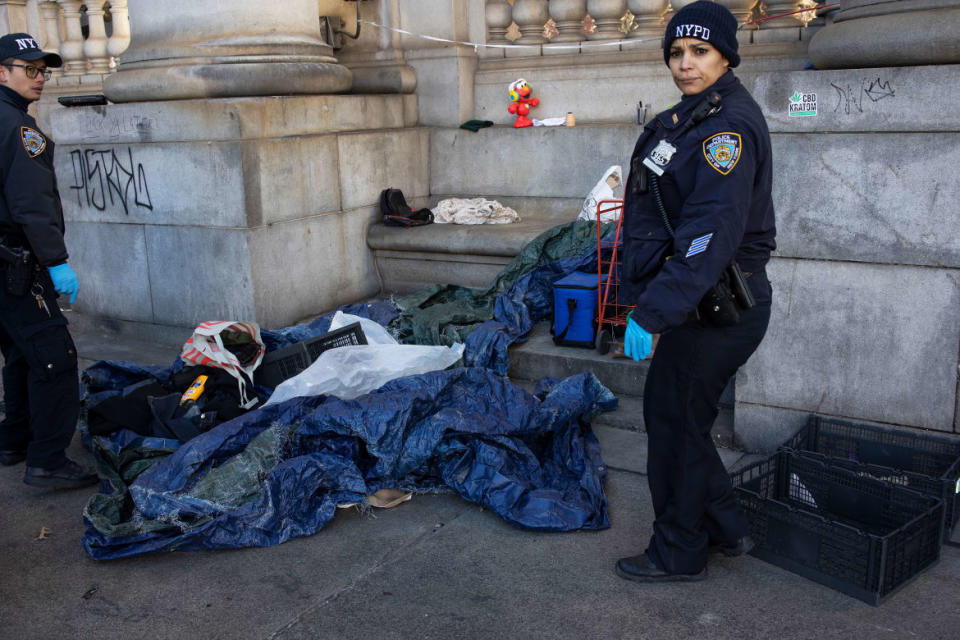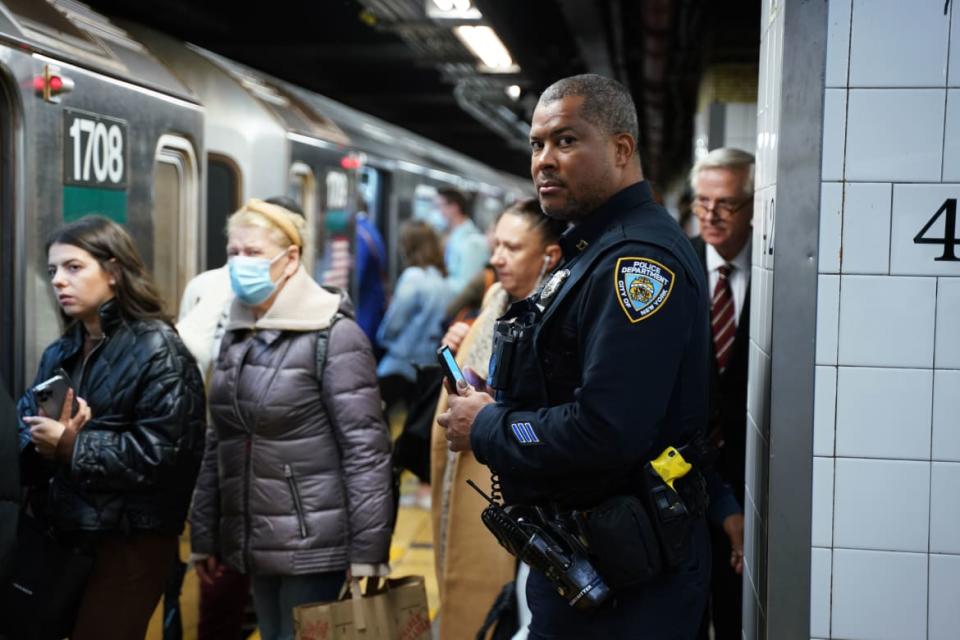Why New York City Mayor Eric Adams’ Most Popular Policies Are His Most Hated

The thing about Mayor Eric Adams' much maligned new plan to bring severely mentally ill people living on the street into hospitals, with or without their consent, is that it’s not really a new plan—and it’s literally the most popular policy in New York City.
When New York City residents were asked earlier this year if they support “Making it easier to admit those who are dangerous to the public, or themselves, to mental health facilities,” 89 percent said yes and 8 percent no—a staggering 11-to-1, with widespread approval in every ideology, income bracket, racial or ethnic group, and borough.
In ‘Straight Line Crazy,’ Ralph Fiennes Turns ‘Master Builder’ Robert Moses Into a Big Bore
Contrary to the impression left by endless headlines, stories, and tweets about Adams’ supposedly malign, Rudy-esque push to forcibly “Clear Streets of Mentally Ill,” and “get more homeless mentally ill people involuntarily committed,” what the mayor actually announced was mostly new guidelines, including police consulting with mental health professionals, for an existing approach of bringing people who appear to be severely mentally ill in for brief periods of stabilization and psychiatric evaluations that, by law, can’t last for more than 72 hours.
The idea is to see if people living on the street—without families to support them, who appear to be suffering from schizophrenia or bipolar disorders while being evidently unable to care for themselves, and often unable to recognize their own conditions and thus unwilling to accept medication—get additional help, rather than a revolving door, including through court-ordered assisted outpatient treatment plans. Those plans, often called AOTs, were created under Kendra’s Law—named for a young journalist who in 1999 was pushed in front of a moving train in Chelsea by a mentally ill young man.
The city also asked for changes to the New York state law that allows police to take into custody anyone “who appears to be mentally ill and is conducting himself or herself in a manner which is likely to result in serious harm to the person or others.” But the statutory language of that law—unlike those everywhere else in America except for Delaware and Washington, D.C.—does not explicitly allow police to do that if someone who’s clearly suffering from mental illness can’t meet their basic human needs, for instance by not wearing pants in the winter, or not covering an open wound, or not eating.
The idea that this amounts to “Bringing Back the Asylum,” as another headline had it, is simply absurd.

Police officers and sanitation crews force a small group of homeless at an encampment at the base of the Manhattan Bridge to move their belongings during a sweep, December 13, 2022, in New York City, New York. Mayor Adams has ordered the city to enforce homeless sweeps, but many homeless just return to their original locations after city officials have left.
In fact, this new plan (or push or policy) is even more popular than other Adams moves that have been widely maligned in “the discourse,” despite what New Yorkers actually think, including “more NYPD officers in the subways” (85 percent support, 14 percent oppose), “breaking up homeless encampments” (60 percent support, 32 percent oppose), and increasing the police budget (52 percent support, more than the combined 27 percent who say it should remain the same and 17 percent who say it should be decreased).
Popular opinion, of course, isn’t always the same thing as decent policy, and an announcement isn’t the same thing as an accomplishment.
Clearing homeless encampments, in particular, is an example of Adams putting his name behind a popular policy—and comparing himself to Jesus Christ in the process—before doing anything much to provide a better alternative to people who’d rather pitch tents than stay in the horrific congregate shelters New York City provides single adults, under its unique and mostly court-created universal “right to shelter.”
New York Crowned Most Expensive City in the World in 2022
And the subway system is now full of cops getting paid overtime to stand in pairs and check their phones, largely indifferent to the mentally ill people inside the same stations and trains, so the MTA can put out reassuring announcements about how “there are officers here if you need assistance.”
All that said, the idea that severely mentally ill people living on the street should just be looked past and left to their own devices—and sometimes to literally wallow in their own filth—until billions get invested in more beds and supportive housing (none of which, by the way, would necessarily do much for people who won’t voluntarily accept those services absent coerced evaluations and AOTs) is morally obscene.
Many of those people, by the way, end up on the streets despite their families’ best efforts to navigate New York’s broken systems of care—as my friend (and former Beast) Alex Brook Lynn, a lifelong New Yorker, laid out in a wrenching FAQ NYC podcast interview elaborating on her recent article about the life and death of her schizophrenic older brother, Zack.
The need to get severely mentally ill people help, even when they’re resistant to taking that help, is obvious to almost everyone outside of those 8 percent of New Yorkers—a group in which advocates, journalists, and city and state lawmakers place themselves in an unacknowledged alliance with police union members who’d rather not have to deal with more EDPs (emotionally disturbed persons, in cop jargon).
That’s what’s wrong with the argument, which longtime New York observer Errol Louis basically laid out here, that the city shouldn’t do anything for the mentally ill homeless until it has a plan for everything.
Nearly a half-century after deinstitutionalization, and thanks in part to the deranged Szaszian idea—embraced by a disturbing number of leftists and libertarians who continue to uphold the legacy of the only psychiatrist with a Batman villain named after him—that psychiatry is fundamentally subjective, mental illness a myth, any treatment a matter of state coercion, and mentally ill street people a feature of big city life, has come to seem like a natural phenomenon. It’s not.

The New York Police Department increased officer presence by approximately 1,200 additional overtime officer shifts each day on the subway to keep people safe after New York Governor Kathy Hochul and New York City Mayor Eric Adams on Saturday, Oct. 19, announced a plan to increase the presence of police officers in the transit system in New York City, New York on October 24, 2022.
Adams is trying to do something concrete to begin to take on what now seems like an intractable problem, but one that, like modern homelessness, only began in the 1980s after deinstitutionalization.
There’s lots that can go wrong with the mayor’s plan, and plenty of reasons for people who care about the mentally ill and about civil liberties to carefully watch how it proceeds. But those who are furious about Adams announcing a plan at all are in effect battling to protect a broken status quo in which mentally ill people simply wander the streets—one that an overwhelming majority of New Yorkers rightly reject.
“The system is really fucked up,” one person involved in the city’s new approach said to me, stressing that the only way not to be paralyzed by the magnitude of the problems and the complexity of the existing bureaucracy to deal with it is to start coming up with new answers to one question at a time, rather than try to solve all of them at once.
The people reflexively opposed to Adams’ effort to do that are living up to the old line, often attributed to Albert Einstein but that in fact probably originated at an Alcoholics Anonymous meeting in the early 1980s, about how insanity is doing the same thing over and over again and expecting different results.
Get the Daily Beast's biggest scoops and scandals delivered right to your inbox. Sign up now.
Stay informed and gain unlimited access to the Daily Beast's unmatched reporting. Subscribe now.


